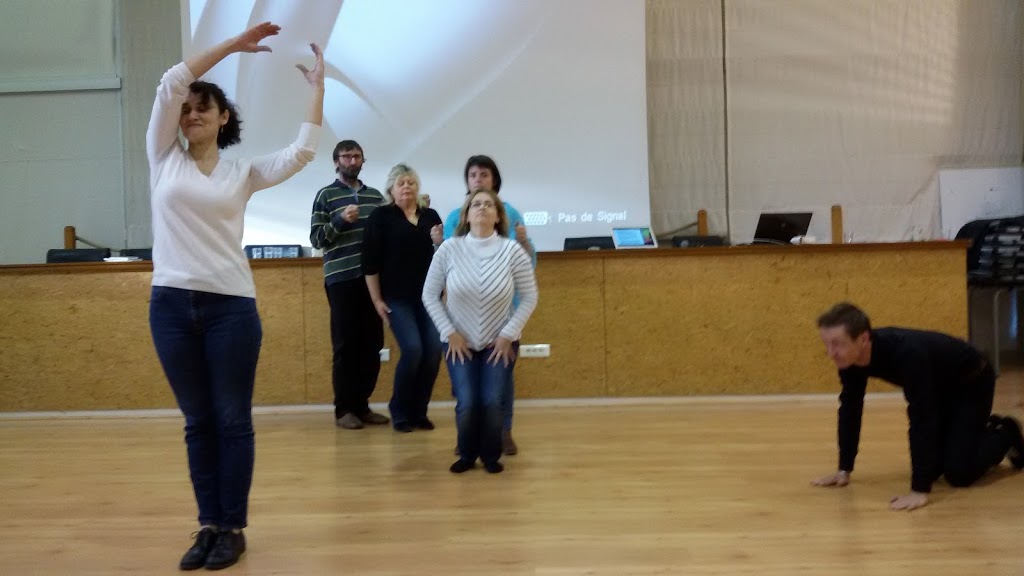Le théâtre en anglais

Ce stage intitulé « ENSEIGNER PAR LE THEATRE EN CLASSE DE LANGUE » et destiné aux professeurs d’anglais proposait un travail autour de l’improvisation, individuelle et collective à travers l’utilisation de supports variés : textes, images, son, objets.
Les stagiaires placés dès le début du stage en mode apprenant ont pu d’une part s’approprier rapidement des outils motivants pour leurs élèves et par-delà apprendre par le corps pour incarner la langue. Autre objectif pédagogique de ce stage : construire les compétences langagières de l’oral et de l’écrit ainsi que les compétences transversales d’écoute, autonomie coopération et médiation.
Tout au long de la première journée de stage, les participants ont donc appris et utilisé un grand nombre de techniques théâtrales de l’improvisation. Lors de pauses « So what ? », les stagiaires étaient invités à analyser les activités auxquelles ils venaient tout juste de participer afin de réfléchir à leur éventuelle transférabilité et utilité pédagogique en cours de langue avec leurs élèves. Enfin, de nombreuses pauses réflectives permettaient aux stagiaires de s’approprier les activités pratiquées à des fin de management de classe.
Les deux journées étaient également marquées par le sceau de l’immersion linguistique, la langue anglaise a été favorisée autant pour la communication que pour le jeu théâtral. Voici quelques exemples d’activités proposées et leurs objectifs :
- Group improv & exposure
Game of improv, to experience what it is like to act out in a funny way, within an absurd yet guided (= safe) situation: the poet, the interpreter, the National Ballet of the faraway country.
The audience chooses the name of a strange country.
The Master of Ceremony introduces the national poet from this country, insisting on the greatness of his talent & recognition. The poet then recites his poem in gibberish (a language that does not exist) translated by the interpreter after each couple of sentences, & illustrated artistically by the dancers in the background (they have a lead dancer whom the others follow; the lead may change in the course of the recitation). Objective: Improv as a collaborative act, creates group cohesion. For the interpreter, it challenges interlinguistic competences. Entertains your audience with fanciful surprises!
- Use of the technique of FEELINGS-ON-THE-WALL to explore a wide range of emotions.
In a line, one group complies to the orders of the other group sitting on the stage opposite them: the group announce emotional states, which the standing group will represent or illustrate in turns: happiness, rage, shock, despair.
In drama we like to show the learners that emotions that are the extreme opposite of each other are connected, interdependent.
Pride goes together with shame, and with modesty. Happiness goes with sadness; shock goes with relief. by associating these contrary emotions, we enrich the range of emotional expression, be it verbal or nonverbal + we teach the pupils to accept the positive & negative emotions alike, in themselves & in others.
Thus “Feeling-on-the-wall” exercises can be done by asking the pupils to pass from one emotion to its contrary in front of the rest of the class, preferably in a group watched by another group.
2 teams, same principle. Window cleaning, or ironing, neutral, then: for the love of your life, for your detested boss, as Snow White ironing the seven shirts of the seven dwarves, as a Martian, as a blind person, as a person who can’t stand heights, as a trained dog, etc. World championship of the fastest, the sexiest ironer/window cleaner etc.
This teaches pupils that there is no right or wrong way to express oneself. Everyone have their own mimics, speed, etc, and the message is always clear. Without words! In order to be in role, they realise that they are telling themselves a story that helps them pretend, enabling them to look & feel natural in the process.
- WORKING ON A SONG: Norwegian Wood by The Beatles (John Lennon)
Different techniques are used:
-tableaux to elicit vocabulary
-imagine the moment of the encounter (beginning of a love story)
-chorus: make the characters speak => alter ego + collective voices
-dreams and nightmares: a character dreams, and the group around him/her voices his/her fears
-conscience alley => contradictory voices assault the character who stands in front of a dilemma, or a decision he has to make
-flash back and flash forward: imagine the situation before then after the moment described in the song
Dans l’après-midi de la deuxième journée, les participants avaient pour mission de présenter un travail dramatisé à partir d’un choix de documents proposés et des techniques d’improvisation théâtrale acquises. Le travail fourni a été de grande qualité, la participation active et enthousiaste.
Nous remercions vivement Catherine Saint Jean pour nous avoir accompagnés lors de ces deux belles journées de formation atypique et réussie !